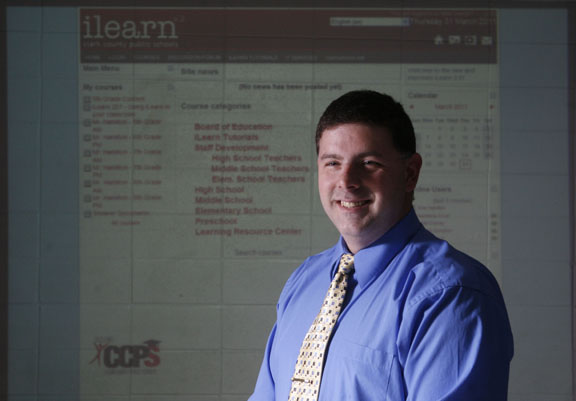
Sixth-grade student Brady Crowe uses Moodle to work on an assignment during Mike Hamilton’s class at Clark Middle School (Clark County). Students were learning to create Excel spreadsheets, and Hamilton was incorporating other class material by using planets and presidents as topics. Photo by Amy Wallot; March 2011
By Susan Riddell
susan.riddell@education.ky.gov
Mike Hamilton, a computer technology teacher at Clark Middle School (Clark County), and Debi Carnefix-Needler, an English teacher at North Bullitt High School (Bullitt County), are using Moodle (Modular Object-Oriented Dynamic Learning Environment) with great success in their classrooms.
Moodle is a course management system, online for almost a decade, but its classroom success has gained momentum the last few years.
“I knew that our district had a Moodle-based system called iLearn and asked one of our technology resource teachers to assist me in setting up my classes,” Hamilton said. “He guided me through the process initially. After the classes were set up and ready to go, I visited the Moodle website to learn a little more about the system.
“Colleges are using these systems more and more as the number of non-traditional students rise and online classes become more popular,” Hamilton added. “By using the technology in my middle school classroom, my students will go to college already knowing how to navigate a Moodle system.”
Using Moodle is a benefit to teachers, too.
“One of the biggest benefits to me is that the Moodle system is a Web-based system,” Hamilton said. “I don’t have to carry papers home to grade. I can log on to iLearn from my computer at home and grade the students’ documents that they have uploaded if I didn’t get to grade them at school.”
One of Hamilton’s first assignments using Moodle deals with the solar system. Students were instructed to create an Excel document after learning information from Windows to the Universe. They made a spreadsheet with the headings for planet, order, mass, distance from sun, rotation, revolution and satellites before listing facts for each of those categories. Hamilton gave specific instructions on how documents should look.
Students have to juggle iLearn, the website and the Excel program. This is typically how students work with Moodle, Hamilton said.
“The students log on and see the instructions for the day’s assignment along with the project rubric,” he said. “Students can create documents, save them and upload files in iLearn.
“Sometimes when I give a test, I have the questions on iLearn, and the students use Microsoft Excel or Microsoft Word to answer the questions and to do the open response,” Hamilton added. “The students then save their work and send it in to me using iLearn. Once the test is graded, the students can see the posted grade.”
Carnefix-Needler uses Moodle in her Advanced Placement classes in ways that students can interact with each other.
It’s a forum “to communicate with team members about projects and presentations for the class,” said Carnefix-Needler, a National Board Certified Teacher.
Students also post responses to in-class reading texts, have a Q-and-A forum to guide group thinking about research topics, post first drafts of arguments and papers, and respond to classmates’ work using a rubric and prior learning to help improve a draft.
“I chose (Moodle) because students can interact with each other out of class,” Carnefix-Needler said. “They guide each other’s thinking and drafting and can more quickly present a finished product to the class or to be graded. I also like the deadline/record of posting times.
“Some students become such excellent responders that pieces are well revised before I have to respond or grade their work, and the quality is much better than when multiple drafts were submitted to me,” she added. “I can briefly respond as needed to help individual students without taking stacks of paper home, and they like being able to improve their work for a presentation or a writing task before I put a grade on it.”
In working with her high school students, Carnefix-Needler has strict guidelines for her tech-savvy students.
“This is academic writing, not a social network,” she said. “Everything required in a formal paper is required in papers uploaded: correct mechanics, complete sentences, words spelled as words, paragraphs, etc. I require replies to peers to be truthful, thorough and thoughtful, and I require a word count for each post and each reply as an additional gauge of depth and quality of work.
“As with anything new, it takes students a few tasks to become comfortable with the process,” Carnefix-Needler added. “Reluctant technology users don’t like it. Those without access from home don’t like it. Those who are chronically late with assignments don’t like it. Usually the quickness of replies from peers and from me is something most students really do like.”

Mike Hamilton uses the Moodle-based system iLearn for class assignments at Clark Middle School (Clark County). Photo by Amy Wallot; March 2011
Both Carnefix-Needler and Hamilton recommend teachers interested in using Moodle try it and make sure students are trained, too.
Carnefix-Needler advised working with school technology staff to get set up and get help troubleshooting. “That person figured it out so much quicker than I could have on my own,” she said.
As for students, Carnefix-Needler recommends as signing a simple task to begin for student buy-in and so students can figure out how to post and reply.
“Before students use Moodle, I spend a semester teaching them the concepts I want included: thesis statements, analysis and argument thesis templates, Toulmin model of argument, supporting claims with evidence and examples, rhetorical devices, rhetorical strategies, sentence structure and types,” Carnefix-Needler said. “So by the time they begin responding to each other, they have knowledge to apply in their responses. Second-semester students post and reply two to three days each week.
“I like it, though I thought I would hate reading so much on a monitor,” she added. “I can respond to them without hauling home so many papers, and I can respond almost instantly. They can so quickly incorporate my suggestions and ideas as they further refine their work.”
MORE INFO …
Mike Hamilton, mike.hamilton@clark.kyschools.us, (859) 744-0427
Debi Carnefix-Needler, debi.carnefix@bullitt.kyschools.us, (502) 869-6261




GREAT JOB MR.HAMILTON !